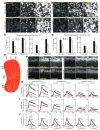Acute and Chronic Pain from Facial Skin and Oral Mucosa: Unique Neurobiology and Challenging Treatment
- PMID: 34071720
- PMCID: PMC8198570
- DOI: 10.3390/ijms22115810
Acute and Chronic Pain from Facial Skin and Oral Mucosa: Unique Neurobiology and Challenging Treatment
Abstract
The oral cavity is a portal into the digestive system, which exhibits unique sensory properties. Like facial skin, the oral mucosa needs to be exquisitely sensitive and selective, in order to detect harmful toxins versus edible food. Chemosensation and somatosensation by multiple receptors, including transient receptor potential channels, are well-developed to meet these needs. In contrast to facial skin, however, the oral mucosa rarely exhibits itch responses. Like the gut, the oral cavity performs mechanical and chemical digestion. Therefore, the oral mucosa needs to be insensitive, to some degree, in order to endure noxious irritation. Persistent pain from the oral mucosa is often due to ulcers, involving both tissue injury and infection. Trigeminal nerve injury and trigeminal neuralgia produce intractable pain in the orofacial skin and the oral mucosa, through mechanisms distinct from those seen in the spinal area, which is particularly difficult to predict or treat. The diagnosis and treatment of idiopathic chronic pain, such as atypical odontalgia (idiopathic painful trigeminal neuropathy or post-traumatic trigeminal neuropathy) and burning mouth syndrome, remain especially challenging. The central integration of gustatory inputs might modulate chronic oral and facial pain. A lack of pain in chronic inflammation inside the oral cavity, such as chronic periodontitis, involves the specialized functioning of oral bacteria. A more detailed understanding of the unique neurobiology of pain from the orofacial skin and the oral mucosa should help us develop novel methods for better treating persistent orofacial pain.
Keywords: chronic pain; mucosa pain; orofacial pain.
Conflict of interest statement
The authors declare no conflict of interest.
Figures





Similar articles
-
Multi-dimensionality of chronic pain of the oral cavity and face.J Headache Pain. 2013 Apr 25;14(1):37. doi: 10.1186/1129-2377-14-37. J Headache Pain. 2013. PMID: 23617409 Free PMC article. Review.
-
Pain Part 5a: Chronic (Neuropathic) Orofacial Pain.Dent Update. 2015 Oct;42(8):744-6, 749-50, 753-4 passim. doi: 10.12968/denu.2015.42.8.744. Dent Update. 2015. PMID: 26685473
-
Differential Diagnosis of Chronic Neuropathic Orofacial Pain: Role of Clinical Neurophysiology.J Clin Neurophysiol. 2019 Nov;36(6):422-429. doi: 10.1097/WNP.0000000000000583. J Clin Neurophysiol. 2019. PMID: 31688325 Review.
-
Atypical odontalgia and trigeminal neuralgia: psychological, behavioral and psychopharmacological approach in a dental clinic - an overview of pathologies related to the challenging differential diagnosis in orofacial pain.F1000Res. 2021 Apr 23;10:317. doi: 10.12688/f1000research.51845.3. eCollection 2021. F1000Res. 2021. PMID: 35966965 Free PMC article.
-
GABA-A receptor activity in the noradrenergic locus coeruleus drives trigeminal neuropathic pain in the rat; contribution of NAα1 receptors in the medial prefrontal cortex.Neuroscience. 2016 Oct 15;334:148-159. doi: 10.1016/j.neuroscience.2016.08.005. Epub 2016 Aug 9. Neuroscience. 2016. PMID: 27520081 Free PMC article.
Cited by
-
Evaluating the Influence of Acute and Chronic Orofacial Pains on the Overall Comprehensive Quality of Life.Cureus. 2024 Jul 1;16(7):e63625. doi: 10.7759/cureus.63625. eCollection 2024 Jul. Cureus. 2024. PMID: 39092385 Free PMC article.
-
Melatonin alleviates oral epithelial cell inflammation via Keap1/Nrf2 signaling.Int J Immunopathol Pharmacol. 2025 Jan-Dec;39:3946320251318147. doi: 10.1177/03946320251318147. Int J Immunopathol Pharmacol. 2025. PMID: 39936565 Free PMC article.
-
Challenges of Diagnosis and Management of Burning Mouth Syndrome: A Literature Review.Curr Aging Sci. 2025;18(2):102-119. doi: 10.2174/0118746098279205240812113353. Curr Aging Sci. 2025. PMID: 40289359 Review.
-
The degeneration-pain relationship in the temporomandibular joint: Current understandings and rodent models.Front Pain Res (Lausanne). 2023 Feb 9;4:1038808. doi: 10.3389/fpain.2023.1038808. eCollection 2023. Front Pain Res (Lausanne). 2023. PMID: 36846071 Free PMC article. Review.
-
Natural Products for the Prevention and Treatment of Oral Mucositis-A Review.Int J Mol Sci. 2022 Apr 15;23(8):4385. doi: 10.3390/ijms23084385. Int J Mol Sci. 2022. PMID: 35457202 Free PMC article. Review.
References
-
- Bradley R.M. Essentials of Oral Physiology. Mosby; St. Louis, MO, USA: 1995.
-
- Dubner R. The Neural Basis of Oral and Facial Function. Springer; Boston, MA, USA: 1978.
-
- Zhao N.N., Whittle T., Murray G.M., Peck C.C. The effects of capsaicin-induced intraoral mucosal pain on jaw movements in humans. J. Orofac. Pain. 2012;26:277–287. - PubMed
Publication types
MeSH terms
Grants and funding
LinkOut - more resources
Full Text Sources
Medical
Research Materials

